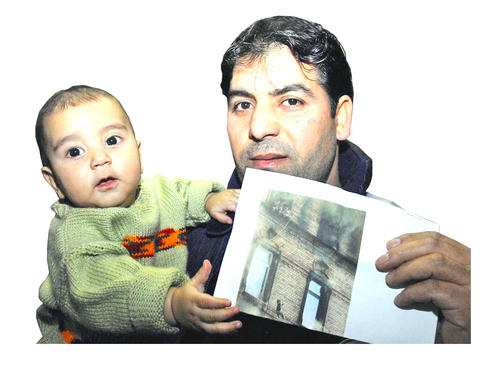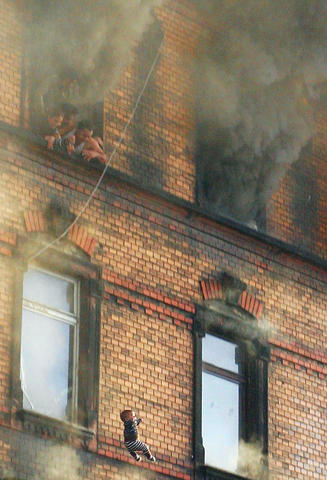The baby
The nightmare scenario of a fire in a packed German tenement block has been captured by one photograph. It shows a small baby in free fall through smoke-filled air. His eyes are closed and his arms are outstretched, as if reaching out for someone. The ground is far, far below. There are no safety nets or blankets, but a forest of arms is already stretching upwards to catch him.
The baby wasn't the only one to fall through the air like this. "People screamed out of open windows. Parents threw their children down, towards the hands of policemen. Then they jumped too," one eyewitness said. But it was the baby that held the world's horrified gaze.

PHOTO: AFP
Within hours of Sunday's blaze it was reported that the baby boy, Onur, had survived. A split second after his uncle threw him from the third floor of the flaming building, a police officer managed to catch him, saving him from hitting the concrete street.
Police confirmed that baby Onur, who is around six months old, was released from hospital yesterday and is doing well.
The police officer

PHOTO: AFP
The police officer, whose identity has not been released, but whose fast reflexes have generated headlines such as "The wonder of Ludwigshafen," was one of 500 emergency workers who raced to the blaze.
"Our colleague was injured as he dived to save the fast-falling baby. His actions meant the baby didn't hit the ground," said Ludwigshafen police spokeswoman Simone Eisenbarth. "He is still recovering. The experience left him in shock and he is having counseling to come to terms with the trauma." He and many of his colleagues are still off duty following the house fire, in which nine people died, including five children and a pregnant woman.
It has been described as the worst fire in western Germany since the World War II. Some 60 people were severely injured and many more were treated by emergency services outside the building on Danziger Platz.
The local mayor honored the rescue services, saying they risked their lives and performed ubermenschlich, or superhuman tasks.
The parents
With a scream, Onur's uncle let the baby fall. The mother cried uncontrollably. Then both jumped out of the smoke-filled window after the child, according to eyewitness reports. The pair, like the majority of people in the building, are Turkish. The police said they are recovering from their injuries. Onur's mother is still in hospital.
The building
The block of flats was more than a century old. It was home to three Turkish families and 24 people were registered as living there.
On Sunday, Ludwigshafen, like towns and cities across western Germany, was in the midst of its annual carnival celebrations, replete with a colorful procession and lots of drink. "The carnival route went right by the building. It seems the flats were crammed with visitors as friends and relatives had come over to celebrate and see the procession," one official said.
Its staircase was made of wood, which went up in flames instantly, trapping everyone. "We had to give up on searching inside. After three or four minutes the stairs collapsed," said firefighter Peter Friedrich.
Kenan Kolat, president of the Turkish organization TBB, yesterday joined family and friends of the victims for a minute's silence by their former home. He described his shock at the desolate remains of the building.
"I have just got back from the site and it was gutted. A ruin. Firemen were carrying away parts of the building to try to find out what happened," he said. "The mood here is so distraught. Some of the children who died were so young, too young to understand. They were just starting out in life. It is tragic. I met a man who lost two children and his wife in the blaze. He was speechless. But what is there to say? He had done his best to help them."
The Bild newspaper published a picture of a three-year-old standing beside his two-year-old brother in a buggy. "Kamil and Kenan. They have not survived," read the caption.
The fire
Germany has been awash with rumor and specu-lation about how the fire started. One young Turkish girl told the N24 television channel that she had seen a man setting fire to a stick near to the house. Someone injured in the blaze told ambulance staff there was a loud bang, like an explosion.
The tragedy has raised fears among Germany's Turkish community of a targeted attack, and Turkish Prime Minister Recep Tayyip Erdogan has echoed their concerns. On Turkish television, he said the country did not want a repeat of 1993's firebomb attack on a house in Solingen, in the far west of Germany, in which five Turks were killed. "After the racist acts of violence in the past the question arises: was this fire an accident or not?" he said.
A delegation headed by State Minister Mustafa Said Yazicioglu would soon leave for Germany to hold talks about the fire, he added.
If it was arson, it may well have been a racially motivated attack, but at the moment, the shell of the building is at risk of caving in, hampering the investigating team's search for evidence. "The roof is being lifted off to take some weight away from the weak structure. It is essential for our work that the building doesn't collapse," a member of the local police force said. Turkey is also sending in a team of investigators to try to find out what happened.
"At the moment we don't even have a vague suspicion or lead about what might have caused this fire," admitted Simone Eisenbarth from the press center of the Ludwigshafen police. She said she had taken phone calls from across Europe.
The photographer
The image of the falling baby was taken by 43-year-old web designer and sport photographer Rene Werse, who happened to be walking past the platz after the carnival.
Werse, who had been taking pictures of the procession, snapped as the baby was mid-air. The picture was beamed worldwide by news agencies. He told a German web magazine how it slowly dawned on him what was happening.
"As I came past the house there was nothing to see, no smell of smoke, but then I saw lots of people on the balconies and at the windows. They were shouting and breaking through the windows," he said.
"The drama wasn't clear from the outside of the building, but rather from the people themselves. There was pure panic on their faces."

The canonical shot of an East Asian city is a night skyline studded with towering apartment and office buildings, bright with neon and plastic signage, a landscape of energy and modernity. Another classic image is the same city seen from above, in which identical apartment towers march across the city, spilling out over nearby geography, like stylized soldiers colonizing new territory in a board game. Densely populated dynamic conurbations of money, technological innovation and convenience, it is hard to see the cities of East Asia as what they truly are: necropolises. Why is this? The East Asian development model, with

June 16 to June 22 The following flyer appeared on the streets of Hsinchu on June 12, 1895: “Taipei has already fallen to the Japanese barbarians, who have brought great misery to our land and people. We heard that the Japanese occupiers will tax our gardens, our houses, our bodies, and even our chickens, dogs, cows and pigs. They wear their hair wild, carve their teeth, tattoo their foreheads, wear strange clothes and speak a strange language. How can we be ruled by such people?” Posted by civilian militia leader Wu Tang-hsing (吳湯興), it was a call to arms to retake

This is a deeply unsettling period in Taiwan. Uncertainties are everywhere while everyone waits for a small army of other shoes to drop on nearly every front. During challenging times, interesting political changes can happen, yet all three major political parties are beset with scandals, strife and self-inflicted wounds. As the ruling party, the Democratic Progressive Party (DPP) is held accountable for not only the challenges to the party, but also the nation. Taiwan is geopolitically and economically under threat. Domestically, the administration is under siege by the opposition-controlled legislature and growing discontent with what opponents characterize as arrogant, autocratic

When Lisa, 20, laces into her ultra-high heels for her shift at a strip club in Ukraine’s Kharkiv, she knows that aside from dancing, she will have to comfort traumatized soldiers. Since Russia’s 2022 invasion, exhausted troops are the main clientele of the Flash Dancers club in the center of the northeastern city, just 20 kilometers from Russian forces. For some customers, it provides an “escape” from the war, said Valerya Zavatska — a 25-year-old law graduate who runs the club with her mother, an ex-dancer. But many are not there just for the show. They “want to talk about what hurts,” she